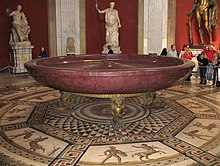Porphyry bowl
The porphyry bowl in the Vatican Museum is the largest one-piece stone bowl from antiquity. It was made from a piece of porphyry , a hard rock , and has a circumference of almost 15 meters, making it one of the largest stone bowls at all. Only the granite bowl in the Lustgarten in Berlin is larger with a circumference of around 23 meters.
History of the porphyry bowl
The bowl comes from Nero's Golden House . Pope Clement IX (1600–1669) left them from the villa of Pope Julius III. Transport it to the Vatican and temporarily set it up there. Today it stands in the Sala Rotunda in the Vatican, where it rests on a bronze pad with four lion's feet.
The porphyry bowl and the location in the rotunda in the Vatican led Karl Friedrich Schinkel to consider installing the granite bowl in Berlin in the rotunda of the Altes Museum , but after its real size became known in 1827, it had to be installed in front of the entrance to the museum. Remarkably, the Berlin bowl is made of red granite and, as explained below, both rocks have the same mineral composition.
Symbolic meaning of porphyry
The Ptolemies brought the original name to Egypt, which occurs on Djebel Duchan (then: mons porphyrites ). Both the red color and the porphyry stone were very rare and reserved by the Romans for the emperors, who were buried in porphyry sarcophagi. This quarry was quarried until the 4th century. This porphyry tradition was continued in many cultures such as Byzantium, the Hohenstaufen emperors, the bishops of the Christian church and the Medici.
Manufacturing
No details are known about the manufacture of the bowl. Like granites, porphyries consist of feldspars , quartz and mica , and they have the same chemical composition. They differ from one another primarily in their origin and, closely related to this, in their structure . Porphyries sometimes offer significantly less resistance than granites during manual processing and are more dense. Nevertheless, the production, which could only be done by hand, is an outstanding technical achievement in the time of Roman antiquity . This affects both the size and the shine of the shell. The clear red coloration of the shell, which is partly explained by an application of paint, cannot be confirmed. Porphyries are colored red when the mineral hematite is present . An intensification of the red color and a corresponding gloss could have been produced either by polishing or (and) by applying waxes or oils. Since the shell in the Sala Rotunda is protected from the effects of weathering , the shine is not endangered by the weathering processes of rocks. The gloss and the resulting light reflection lead to interesting considerations (see web link) in the literature.
See also
Web link
- Comparison of light reflections from porphyry and granite bowls (page 3 and 4) (PDF file; 1.28 MB)
Individual evidence
- ^ Bernard Andreae: Picture catalog of the sculptures of the Vatican Museum. Walter de Gruyter, 1998, ISBN 978-3-110-14629-5 , p. PR9 ( limited preview in Google book search).
- ↑ Dietmar Reisch: Natural stone studies. An introduction for civil engineers, architects, preservationists and stonemasons. Enke, Stuttgart 1991, p. 124.
